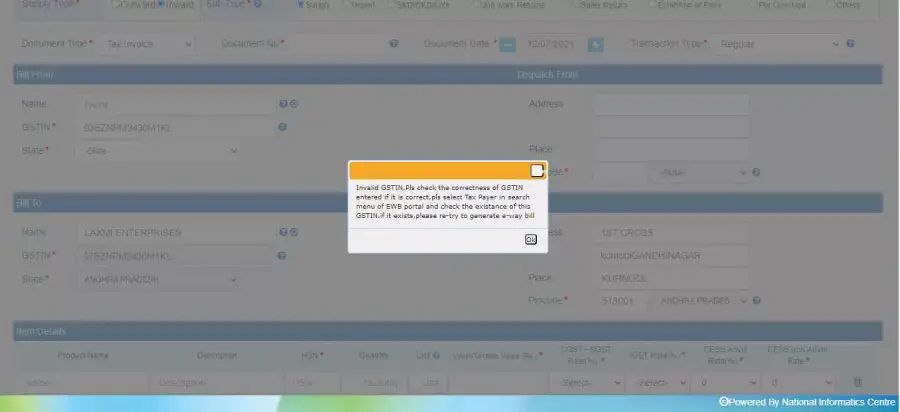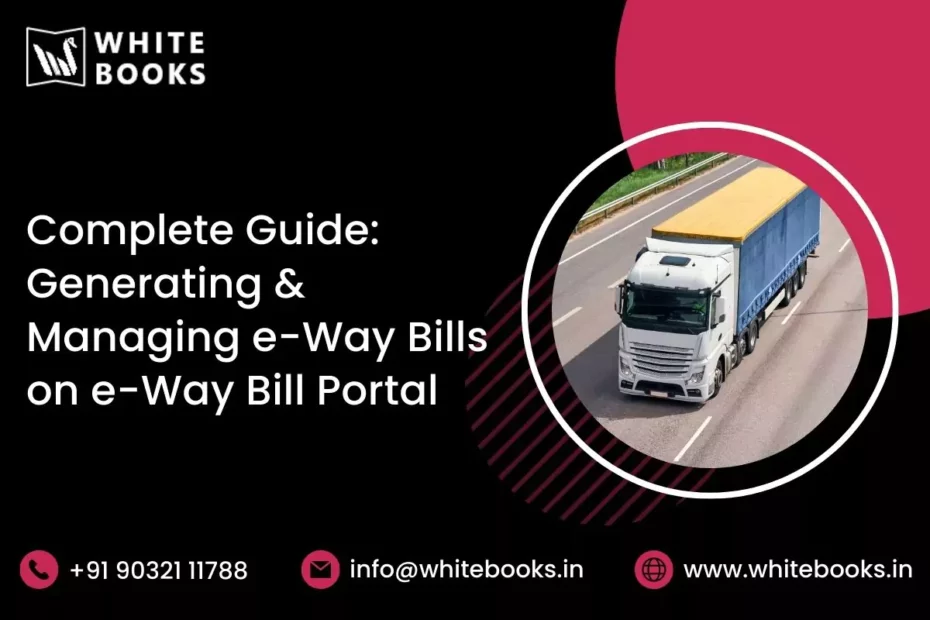Generating a New e-Way Bill
The option to generate a new e-Way Bill allows users to create a new electronic waybill for transporting goods. By selecting the ‘Generate New’ sub-option under the ‘e-waybill’ menu, users are presented with an EWB Entry Form where they can input the necessary details for e-way bill generation.
To initiate the process, users should have the relevant Invoice/Bill/Challan document details and be aware of the Transporter ID or vehicle details (Part-B) for the consignment’s transportation.
In the EWB Entry Form, the user is prompted to select the transaction type, either Outward (supplying goods) or Inward (receiving goods). Based on the selected transaction type, the system displays the corresponding sub-types of transactions. The user must choose the appropriate sub-type accordingly.
Upon selecting the transaction type and sub-type in the ‘Transaction Details’ section, the system dynamically filters the available document types in the ‘Document Type’ dropdown, displaying only the relevant options.
By providing accurate information and completing the necessary fields in the EWB Entry Form, users can successfully generate a new e-Way Bill for their consignment, facilitating smooth and compliant transportation of goods.
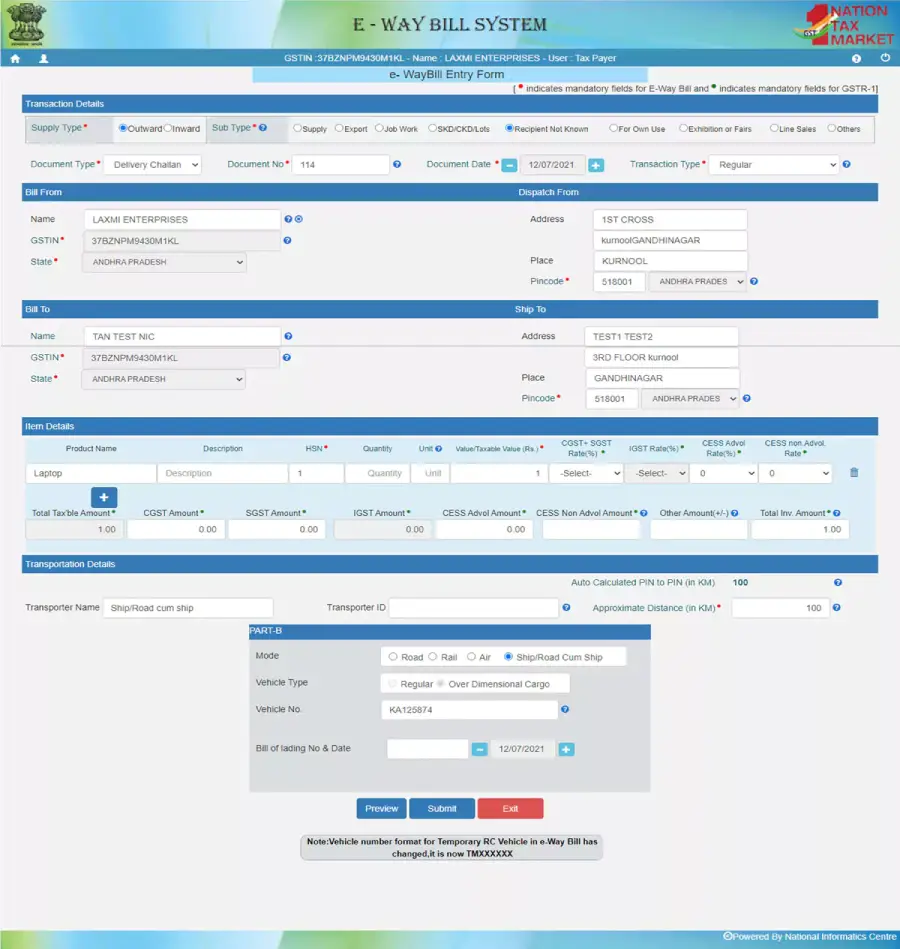
Case I: Outward Transactions
| S No | Transaction Sub-Type | Document Type | To GSTIN (Bill To) | Description |
|---|---|---|---|---|
| 1 | Supply | Tax Invoice | Other GSTIN/ URP | This is used for the regular sale transactions, where sale has taken place based on ‘Tax Invoice’, ‘Bill of Supply’. |
| Bill of Supply | Other GSTIN/ URP | |||
| 2 | Export | Tax Invoice | URP | This is used for the export transactions, where sale/export has taken place based on ‘Tax Invoice’, ‘Bill of Supply’. |
| Bill of Supply | URP | |||
| 3 | Job Work | Delivery Challan | Other GSTIN/ URP | This is used when the goods are moved for job work with ‘Delivery Challan’. |
| 4 | SKD/CKD/Lots | Tax Invoice | Other GSTIN/ URP | This is used when the goods are moved in completely or semi knocked down condition or in lots. Under this condition, the tax payer will move the parts of the goods along with the ‘Delivery Challan’ and copy of the ‘Tax Invoice’ and last consignment with ‘Delivery Challan’ and original Invoice. |
| Bill of Supply | Other GSTIN/ URP | |||
| Delivery Challan | Other GSTIN/ URP | |||
| 5 | Recipient Not Known | Delivery Challan | Self | This is used when the goods are taken out from the premises of the tax payers for the sales at the door steps of the clients. The goods are taken out with the ‘Delivery Challan’. |
| Others | Self | |||
| 6 | For Own Use | Delivery Challan | Self | This is used when the goods are moved between the business places of the tax payers. Generally, it is moved with ‘Delivery Challan’. |
| 7 | Exhibition or Fairs | Delivery Challan | Self | This is used when the goods are taken out from the premises of the tax payers to the premises of the Exhibitions or Fairs. The goods are taken out with the ‘Delivery Challan’. |
| 8 | Line Sales | Delivery Challan | Self | This is used when the goods are taken out from the premises of the tax payers for the sales at the door steps of the clients. The goods are taken out with the ‘Delivery Challan’ and whenever the sales are made to the clients, the ‘Taxable Invoice’ or ‘Bill of Supply’ is issued to the amount of the sale taken place. |
| 9 | Others | Delivery Challan | Self/ Other GSTIN/ URP | This is used when the goods are taken on another type of supply. It is necessary for the tax payers to specify the sub-supply type. |
| 10 | Others | Delivery Challan | Self/ Other GSTIN/ URP | If the sub type is selected as other then it is mandatory to enter the description in box |
Case II: Inward Transactions
| S No | Transaction Sub-Type | Document Type | To GSTIN (Bill To) | Description |
|---|---|---|---|---|
| 1 | Supply | Tax Invoice | Other GSTIN/ URP | This is used for the regular sale transactions, where sale has taken place based on ‘Tax Invoice’, ‘Bill of Supply’. |
| Bill of Supply | Other GSTIN/ URP | |||
| 2 | Export | Bill of Entry | URP | This is used for the import transactions, where purchase/import has taken place based on ‘Bill of Entry’. |
| 3 | SKD/CKD/Lots | Bill of Entry | URP | This is used when the goods are purchased and moved in completely or semi knocked down condition or in lots. Under this condition, the tax payer will move the parts of the goods along with the ‘Delivery Challan’ and copy of the ‘Tax Invoice’ or ‘Bill of Entry’ and last consignment with ‘Delivery Challan’ and original Invoice/Bill of Entry. |
| Tax Invoice | Other GSTIN/ URP | |||
| Bill of Supply | Other GSTIN/ URP | |||
| Delivery Challan | Other GSTIN/ URP | |||
| 4 | Job Work Returns | Delivery Challan | Other GSTIN/ URP | This is used when the goods are moved for job work with ‘Delivery Challan’. |
| 5 | Sales Return | Delivery Challan | Other GSTIN/ URP | This is used when the goods are brought back from the client premises because of rejection of the goods or not ready to accept the goods. |
| 6 | Exhibition or Fairs | Others | Self | This is used when the goods are taken out from the premises of the tax payers to the premises of the Exhibitions or Fairs. The goods are taken out with the ‘Delivery Challan’. |
| 7 | For Own Use | Delivery Challan | Self | This is used when the goods are moved between the business places of the tax payers. Generally, it is moved with ‘Delivery Challan’. |
| 8 | Others | Delivery Challan | Self/ Other GSTIN/ URP | This is used when the goods taken on another type of supply. It is necessary to the tax payers to specify the sub-supply type. |
| Others | Self/ Other GSTIN/ URP |
The user must select the appropriate document type from the dropdown menu based on the document in their possession. They must enter the document number and select the document date, ensuring that the document number is unique for each e-Way Bill and the document date is not later than the current date.
In the case of an outward transaction, the user needs to provide the details of the “Bill From” section, including the name, GSTIN, and address. If the user has multiple places of business, they can edit the address in the “Dispatch From” section.
For an inward transaction, the user must enter the details of the “Bill From” section, including the name, GSTIN, state, and address. These details can be automatically populated if the consignor information has been previously entered in the Supplier Master. The system displays the relevant consignor names based on the characters entered by the user, allowing them to select the correct consignor. The auto-populated details can be edited if necessary. If the consignor is unregistered for GST, the user can enter “URP” as the GSTIN to indicate an “Unregistered Person.”
In the case of an outward transaction, the user needs to enter the consignee’s details in the “Bill To” section, including the name, GSTIN, and address. The system can auto-populate the consignee details if they have been previously entered in the Client Masters. By entering a few characters of the consignee name, the system displays the related names for selection. The GSTIN, state, and address fields are automatically filled but can be edited by the user. If the consignee details are not available in the master, the user must manually enter the complete details. For unregistered consignees, the user should enter “URP” in the GSTIN column to indicate an “Unregistered Person.”
In an inward transaction’s “Bill To” section, the recipient’s name, GSTIN, and address are auto-populated with the user’s details. If the user has additional places of business, they can select the appropriate place. The system allows the user to edit the address, even though it is auto-updated.
Next, the user must provide details of the products to be shipped in the “Item Details” section. The product details can be auto-populated if the user has entered them in the Product Masters. By entering a few characters of the product name, the system allows the user to select the corresponding product name from the master. Fields such as description, HSN, unit, and tax rate are automatically filled based on the master.
It’s important to note that an e-Way Bill cannot be generated with only SAC codes (99) for services; at least one HSN code for goods is mandatory.
The user then needs to enter the quantity and total taxable value. The standard tax rates (%) are auto-populated from the dropdown menu when entering the HSN code. The taxpayer must select the applicable tax rate slab in the respective tax categories. However, for the “CESS Non-Advol Rate,” the taxpayer must select the applicable tax rate in rupees instead of a percentage, unlike other tax rate fields.
The user can add multiple products by clicking on a button. The system calculates the CGST, SGST, IGST, and CESS amounts based on the taxable value and tax rates. The user has the flexibility to edit the auto-populated amounts if needed. However, the CESS Non-Advol amount is not auto-populated as it depends on the quantity and unit. Therefore, the taxpayer must manually enter this amount in the “CESS non-Advol. Amount” field.
It’s important to note that the system will display the CGST and SGST tax rates for intra-state movements and the IGST tax rate for inter-state movements.
Lastly, the user must enter the transportation details in the “Transportation Details” section. This includes the transporter name, transporter ID, and the approximate distance (in kilometers) to be covered by the shipment.
The e-waybill system has an auto-calculation feature that estimates the motorable distance between the supplier and recipient addresses based on the entered PIN codes in the “Bill From & Bill To” section. The system also allows the user to enter the distance traveled, but it is limited to a range of +/- 10% of the auto-calculated distance. If the source and destination PIN codes are the same, the user can enter a maximum distance of 100 kilometers. In the Part-B section, the user needs to select the mode of transportation (road, rail, air, or ship/road cum ship) and provide details such as vehicle number and transporter document number and date. If the user is transporting the goods directly without a transporter, they can enter the vehicle number without the transporter details.
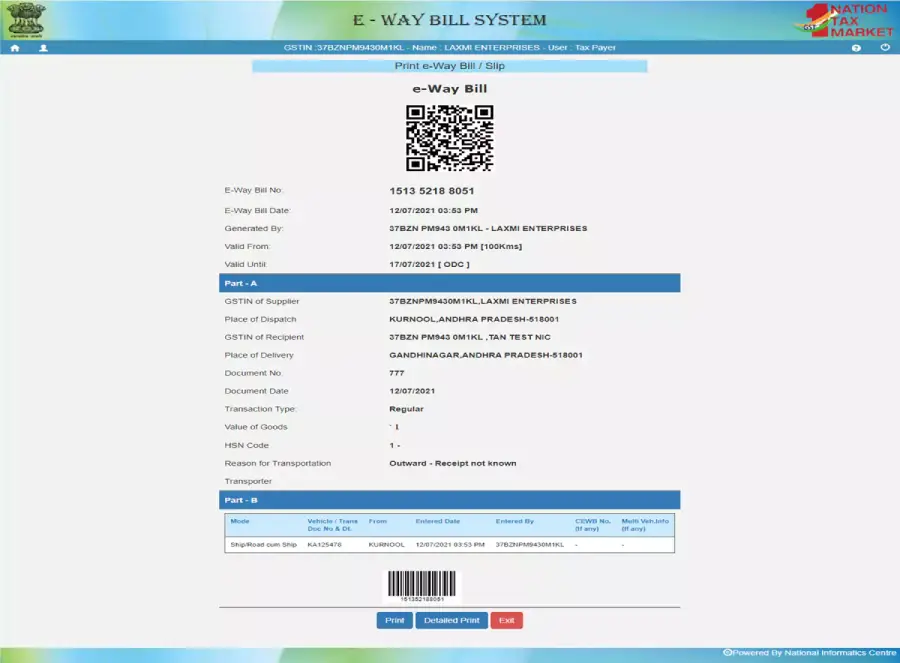
Note: The mode of transport, “Ship,” has been updated to “Ship/Road cum Ship.”
Transaction Details:
Duplicate Invoice Checking
To ensure the integrity of the e-way bill system, it incorporates a feature to prevent the generation of duplicate e-way bills based on the same invoice number. The system performs checks to avoid multiple e-way bills generated for a single document by the consignor/supplier.
The duplicate check is based on the following criteria:
- Consignor GSTIN: The system verifies if the consignor has already generated an e-way bill for a particular invoice.
- Document Type: The system considers the type of document (invoice, Bill, challan, etc.) associated with the e-way Bill.
- Document Number: The system compares the document numbers to identify duplications.
If the consignor has already generated an e-way bill for a specific invoice, the system prohibits them from generating another e-way bill using the same invoice number. Similarly, if the transporter or consignee has already generated an e-way bill for the consignor’s invoice, any other party (consignor, transporter, or consignee) attempting to generate an e-way bill will receive an alert indicating that an e-way bill for that invoice already exists. The system allows them to generate another e-way bill only if they choose to do so.
This duplicate invoice-checking mechanism helps maintain data accuracy and ensures each invoice is associated with a unique e-way bill within the system.
Transaction Types
When generating an e-way bill, it is important to specify the transaction type, which determines the number of parties involved in the billing and movement of goods. There are four types of transactions to choose from:
Regular Transaction:
- In a regular transaction, two parties are involved: the consignor (supplier) and the consignee (recipient).
- Billing and goods movement occurs directly between the consignor and consignee.
Bill to – Ship To Transaction:
- This transaction involves three parties: the consignor, the consignee, and a third party.
- Billing occurs between the consignor and consignee, but the goods are physically moved from the consignor to the third party per the consignee’s request.
Bill from – Dispatch From Transaction:
- Similar to the Bill to Ship To transaction, this transaction involves three parties: the consignor, the consignee, and a third party.
- Billing occurs between the consignor and consignee, but the consignor physically moves the goods from the third party to the consignee.
Combination Transaction:
- This transaction type combines the Bill to Ship To and Bill from Dispatch From transactions.
- It involves four parties: the consignor, the consignee, a third party, and a fourth party.
- Billing occurs between the consignor and consignee, and the goods are moved by the consignor from the third party to the fourth party per the consignee’s request.
By selecting the appropriate transaction type, the e-way bill system can accurately capture the complexities of the billing and goods movement process, ensuring compliance and transparency throughout the transaction.

Document Number:
The Document Number field, located under the Transaction Details tab, is a case-sensitive field that accepts alphanumeric values and special characters “/” or “-.” It is important to note that any special character other than “/” or “-” will not be accepted in the Document Number field.
When generating an e-way bill, ensure that the Document Number entered accurately reflects the corresponding document, such as an invoice, Bill, or challan number. By adhering to the specified format and limitations, the e-way bill system can effectively validate and process the document information, promoting accuracy and consistency in the e-way bill generation process.
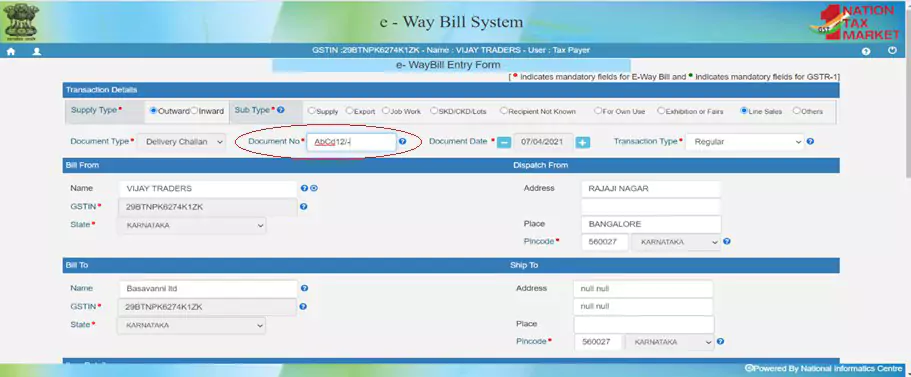
For Own Use
When selecting the “For Own Use” option as the Sub Type in the Transaction Details section, the system will automatically set the PIN codes of both “Bill from” and “Bill to” as the same. Additionally, the auto-calculated pin-to-pin distance will be displayed as 100km.
“For Own Use” refers to situations where the goods are transported for internal purposes or within the same entity without involving external parties. By setting the PIN codes to the same value and displaying a standardized distance, the e-way bill system simplifies the process for such transactions, providing convenience and ease of use.
Line Sales
If users select “Line Sales” as the Sub Type in the Transaction Details section, it is important to note that the maximum distance allowed for transportation is 300 kilometers. This restriction helps streamline the process and ensures that the transportation of goods adheres to the specified distance limit.

Vehicle Number
When entering the vehicle number in the e-way bill system, there are certain validations and checks performed by the system. First, the system checks the format of the vehicle number to ensure it meets the required criteria. Once the format is validated, the system further verifies if the vehicle number is available in the Vahan system, a centralized vehicle registration database.
If the vehicle number is found in the Vahan system, the system displays the associated vehicle class details. This information helps in accurately identifying and documenting the type of vehicle being used for transportation.
However, if the entered vehicle number is unavailable in the Vahan system, the system alerts the user that the vehicle information is not found. This ensures that the user knows the discrepancy and can take appropriate actions, such as verifying the vehicle number or contacting the relevant authorities for clarification.
It is important to note that temporary vehicle numbers can also be inserted for e-way bill generation. The system accommodates temporary vehicle numbers and allows them to generate the e-way Bill.
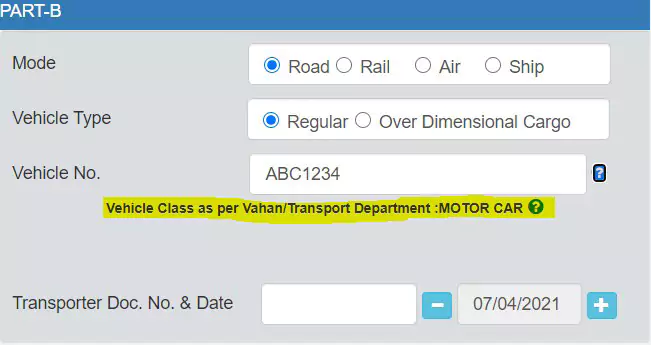
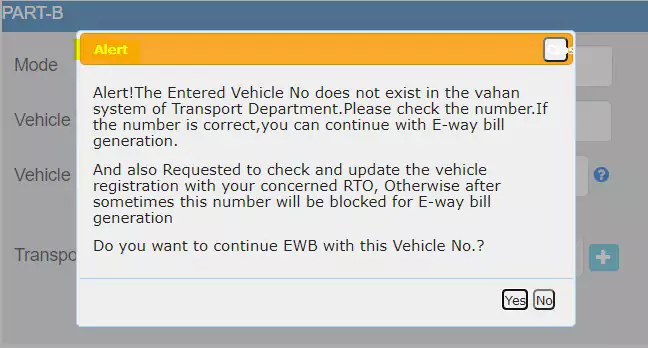

Note: The specific format for temporary RC vehicle numbers in the e-way bill system will be provided or displayed to users to ensure accurate input for generating the e-way Bill.
IRN Info at Print Page
When an e-waybill is generated from the e-Invoice portal, the e-waybill print will also display IRN (Invoice Reference Number) information. The IRN is a unique identification number assigned to each invoice generated on the e-Invoice portal. It serves as a reference for the corresponding invoice and helps in validating the authenticity of the invoice.
Including the IRN information in the e-waybill print provides additional details and ensures the traceability of the invoice associated with the e-waybill. This helps streamline the documentation process and facilitates easier verification during the transportation and delivery of goods.
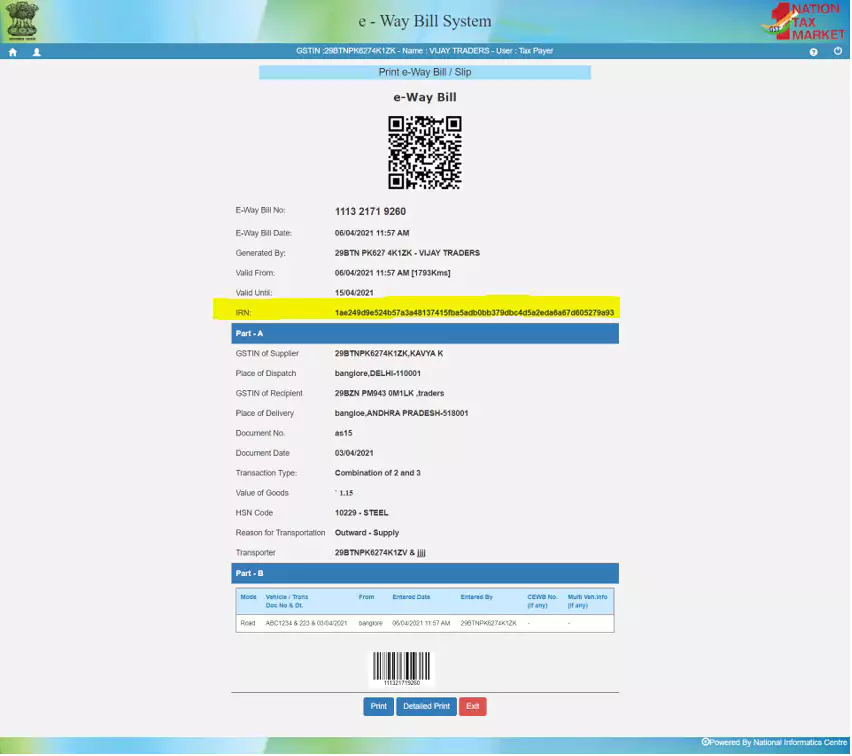
The Blocking/Unblocking of E-Way Bill Generation
In the e-Way Bill system, a feature allows blocking or unblocking a taxpayer’s GSTIN (Goods and Services Taxpayer Identification Number) based on certain criteria. If a GST-registered taxpayer fails to file Return 3B for two consecutive months on the GST Common Portal, their GSTIN will be allowed to generate other e-way bills.
Blocking
When a taxpayer’s GSTIN is blocked, they will encounter the following situations:
a) Pop-up Message: Every time the blocked taxpayer attempts to generate a new e-way bill or perform bulk generation, a pop-up message (refer to Figure 18) will notify them about the blocking status.
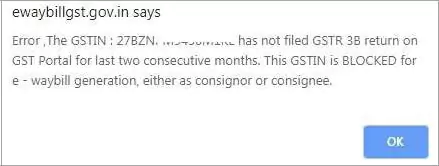
Unblocking
Once the taxpayer files Return 3B on the GST Common Portal, their blocked GSTIN will automatically be updated as ‘Unblocked’ within a day in the e-Way Bill system. This enables the taxpayer to resume generating e-way bills. However, if the status is not updated in the e-Way Bill system, the taxpayer can manually update it by following these steps on the e-Way Bill portal:
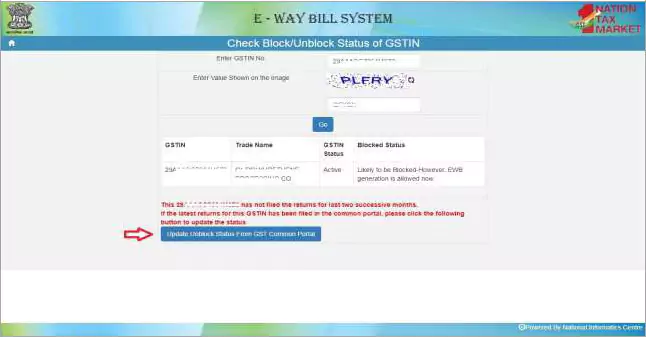
- Search and Update Block Status: On the e-Way Bill portal, select ” Update Block Status ” in the “Search” section and select “Update Block Status.”
- Enter GSTIN: Enter the GSTIN of the blocked taxpayer.
- CAPTCHA Verification: Complete the CAPTCHA verification.
- Click “GO”: Click on the “GO” button to proceed.
- Click the Button: To fetch the filing status from the GST Common Portal, click the button.
- Status Update: If the return has been filed, the status in the e-Way Bill system will be subsequently updated.
